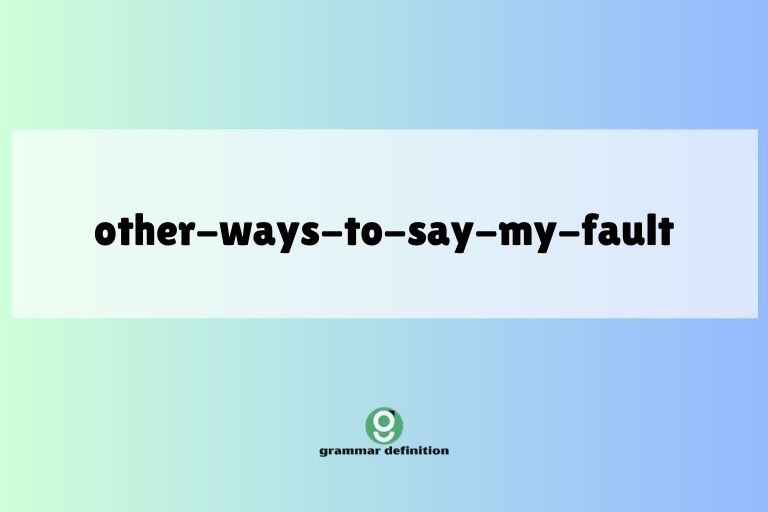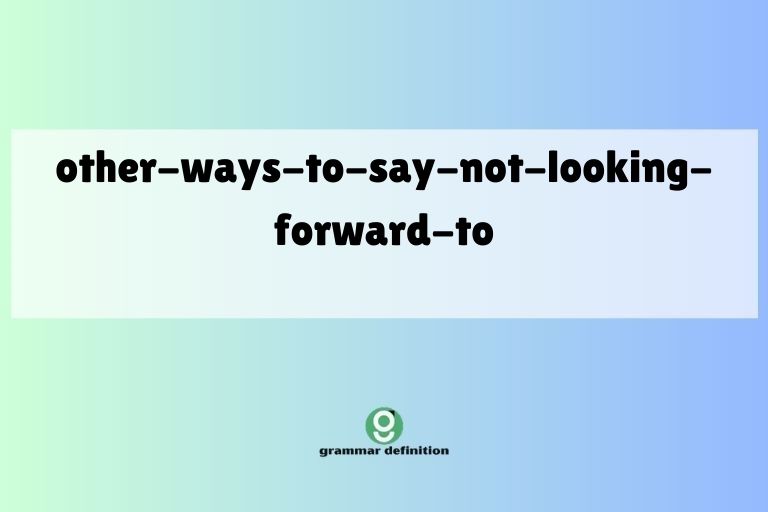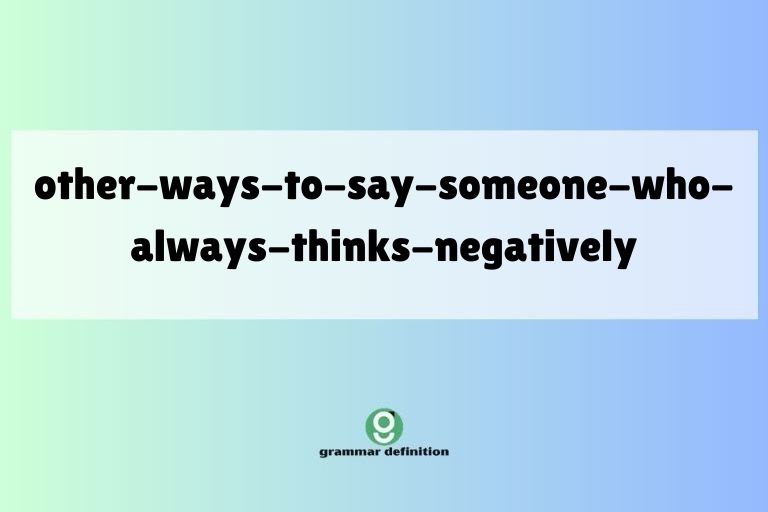Beyond “My Fault”: Diverse Ways to Express Responsibility

Acknowledging responsibility is a crucial aspect of effective communication and personal accountability. While saying “my fault” is straightforward, relying solely on this phrase can limit your expressiveness and make you sound repetitive.
Mastering alternative ways to express responsibility allows you to convey nuances, show sincerity, and adapt to various social and professional contexts. This article explores a wide range of phrases and expressions that go beyond the simple “my fault,” providing you with the tools to communicate more effectively and take ownership of your mistakes with grace and precision.
Whether you’re an English language learner or a native speaker looking to refine your communication skills, this guide will enhance your vocabulary and improve your ability to express responsibility in a variety of situations.
This article will benefit English language learners, professionals aiming to improve their communication skills, and anyone who wants to expand their vocabulary related to expressing responsibility. By learning these alternative phrases, you’ll be able to communicate more effectively and appropriately in different contexts, fostering better relationships and demonstrating a higher level of emotional intelligence.
Table of Contents
- Definition: Expressing Responsibility
- Structural Breakdown
- Types and Categories of Expressions
- Examples of Alternative Phrases
- Usage Rules and Context
- Common Mistakes to Avoid
- Practice Exercises
- Advanced Topics
- Frequently Asked Questions
- Conclusion
Definition: Expressing Responsibility
Expressing responsibility involves acknowledging your role in a mistake, error, or negative outcome. It’s a crucial aspect of communication that demonstrates accountability, sincerity, and respect for others.
It goes beyond simply saying “my fault” and encompasses a range of phrases and expressions that convey different levels of ownership and regret. The specific phrase you choose will depend on the context, the severity of the mistake, and your relationship with the person or people affected.
Classifying expressions of responsibility helps to understand the nuances of each phrase and how they are used in different situations. These expressions can be classified based on their directness, formality, and the level of remorse they convey.
For instance, a direct admission of fault is suitable for informal settings, while a more formal apology is appropriate for professional or serious situations. Understanding these classifications allows for more effective and appropriate communication.
The function of expressing responsibility is multifaceted. Primarily, it aims to acknowledge a mistake and take ownership of it.
It can also serve to mitigate the negative impact of the mistake, demonstrate empathy towards those affected, and rebuild trust. Furthermore, it can be used to signal a willingness to rectify the situation and prevent similar errors in the future.
The context of the situation will dictate which function is most important and how the expression of responsibility should be delivered.
Structural Breakdown
Expressions of responsibility often follow specific grammatical structures. These structures can include:
- Subject + Verb + Adjective/Noun: I am responsible. I made a mistake.
- It + is/was + Adjective + of + Subject + to + Verb: It was careless of me to forget.
- Gerund Phrase: Forgetting the appointment was my fault.
- Passive Voice: The error was made by me.
The choice of structure can influence the level of formality and the emphasis placed on the person taking responsibility. Using “I” as the subject typically indicates a direct acceptance of blame, while using the passive voice can sometimes soften the impact of the admission.
Understanding the grammatical structure helps in constructing phrases that accurately convey the intended meaning. By analyzing the components of these phrases, language learners can better grasp the nuances of expressing responsibility and use them effectively in their communication.
Types and Categories of Expressions
Expressions of responsibility can be categorized based on their level of directness, formality, and the specific emotion they convey. Here are some key categories:
Direct Admission of Fault
These phrases explicitly state that you are responsible for the mistake. They are often used in informal settings and convey a clear sense of accountability.
Direct admissions leave no room for ambiguity and demonstrate a willingness to take ownership of the error.
Indirect Admission of Fault
These phrases acknowledge the mistake without directly assigning blame to yourself. They can be used when you want to soften the impact of the admission or when the responsibility is shared.
Indirect admissions are often used in more formal or professional contexts.
Taking Blame and Responsibility
These phrases explicitly state that you are taking the blame or responsibility for the mistake. They are often used in situations where the consequences of the mistake are significant.
Taking blame demonstrates a strong sense of accountability and a willingness to face the consequences of your actions.
Expressing Regret and Apologizing
These phrases express remorse for the mistake and offer an apology to those affected. They are used to show empathy and demonstrate a desire to make amends.
Expressing regret and apologizing is crucial for repairing relationships and restoring trust.
Euphemistic Expressions
These are milder or more indirect ways of acknowledging a mistake, often used to avoid being too blunt or to downplay the severity of the situation. Euphemisms can be useful in delicate situations where a direct admission of fault might be too harsh.
However, it’s important to use them judiciously to avoid appearing insincere or evasive.
Examples of Alternative Phrases
Here are several examples of alternative phrases to “my fault,” categorized by the types discussed above.
Direct Admission Examples
The following table provides examples of direct admissions of fault. These phrases are straightforward and leave no doubt about who is responsible.
| Phrase | Example Sentence |
|---|---|
| I messed up. | I messed up the presentation, and I’m sorry for the confusion. |
| I was wrong. | I was wrong about the deadline; it’s actually tomorrow. |
| That was my bad. | That was my bad; I should have double-checked the numbers. |
| I goofed. | I goofed and sent the wrong email to the client. |
| I screwed up. | I screwed up the calculations, and now we have to redo them. |
| I slipped up. | I slipped up and forgot to call him back. |
| I take full responsibility. | I take full responsibility for the delay in the project. |
| It was my mistake. | It was my mistake to assume they knew the procedure. |
| I am to blame. | I am to blame for the error in the report. |
| I’m the one who… | I’m the one who forgot to lock the door. |
| I overlooked that. | I overlooked that crucial detail, and it caused a problem. |
| I didn’t handle that well. | I didn’t handle that situation well, and I regret it. |
| I should have known better. | I should have known better than to trust that source. |
| I take the blame. | I take the blame for the misunderstanding. |
| It’s on me. | It’s on me; I’ll fix it right away. |
| My apologies; I am at fault. | My apologies; I am at fault for the incorrect information provided. |
| Clearly, the error originated with me. | Clearly, the error originated with me, and I will rectify it immediately. |
| I own that mistake. | I own that mistake, and I’m committed to preventing it from happening again. |
| I was remiss. | I was remiss in my duties and failed to follow up promptly. |
| This is my responsibility. | This error is my responsibility, and I’ll ensure it’s corrected. |
| I failed to do what I should have. | I failed to do what I should have, and I understand the consequences. |
| I am culpable. | I am culpable for the oversight in the contract. |
| I am accountable. | I am accountable for the project’s failure to meet the deadline. |
| The fault lies with me. | The fault lies with me for the miscommunication. |
Indirect Admission Examples
The following table provides examples of indirect admissions of fault. These phrases acknowledge the mistake without directly assigning blame.
They are often used in more formal or professional settings.
| Phrase | Example Sentence |
|---|---|
| There seems to have been a misunderstanding. | There seems to have been a misunderstanding regarding the project requirements. |
| I didn’t explain that clearly enough. | I didn’t explain that clearly enough, so let me clarify. |
| I could have done better. | I could have done better in managing the team’s expectations. |
| This could have been handled differently. | This situation could have been handled differently, and I’ll learn from it. |
| An error occurred on my part. | An error occurred on my part, which led to the delay. |
| I regret that this happened. | I regret that this happened and will take steps to prevent it in the future. |
| We should have been more careful. | We should have been more careful in our analysis of the data. |
| I wish I had… | I wish I had checked the figures before submitting the report. |
| It appears there was an oversight. | It appears there was an oversight in the planning stage. |
| I’m not sure what happened. | I’m not sure what happened, but I’ll investigate the cause. |
| That wasn’t ideal. | That wasn’t ideal; we need to review our processes. |
| It seems there was a lapse in judgment. | It seems there was a lapse in judgment on my part. |
| Perhaps I could have managed this more effectively. | Perhaps I could have managed this more effectively with better planning. |
| I may have contributed to the issue. | I may have contributed to the issue through a lack of communication. |
| It wasn’t my best moment. | It wasn’t my best moment, and I’ll strive to improve. |
| In retrospect, I should have handled that differently. | In retrospect, I should have handled that differently and communicated more clearly. |
| I acknowledge that things could have gone smoother. | I acknowledge that things could have gone smoother with better coordination. |
| There may have been a misstep on my end. | There may have been a misstep on my end that contributed to the problem. |
| I’m not entirely blameless in this situation. | I’m not entirely blameless in this situation; I could have been more proactive. |
| I recognize that my actions might have had an impact. | I recognize that my actions might have had an impact on the outcome. |
| We encountered some difficulties. | We encountered some difficulties during the implementation phase. |
| There was a slight hiccup. | There was a slight hiccup in the system that caused the delay. |
| Things didn’t go exactly as planned. | Things didn’t go exactly as planned, and we’re working to rectify the situation. |
| We faced some unexpected challenges. | We faced some unexpected challenges that affected the timeline. |
| There were some unforeseen circumstances. | There were some unforeseen circumstances that led to the error. |
Taking Blame Examples
The following table provides examples of phrases that explicitly take the blame or responsibility for the mistake. These phrases are often used in situations where the consequences of the mistake are significant.
| Phrase | Example Sentence |
|---|---|
| The buck stops here. | The buck stops here; I’m responsible for ensuring this doesn’t happen again. |
| I’ll carry the can. | I’ll carry the can for this mistake; it’s my responsibility to fix it. |
| I’ll take the fall. | I’ll take the fall for the error; I should have been more vigilant. |
| I am solely responsible. | I am solely responsible for the oversight that led to the problem. |
| I accept full accountability. | I accept full accountability for the project’s failure. |
| I’m the one to answer for this. | I’m the one to answer for this breach of protocol. |
| I will bear the consequences. | I will bear the consequences of my actions. |
| I will face the music. | I will face the music for my poor decision-making. |
| I own this completely. | I own this error completely and will take steps to correct it. |
| I am entirely to blame. | I am entirely to blame for the miscommunication. |
| I assume responsibility for this oversight. | I assume responsibility for this oversight and its consequences. |
| I bear the weight of this mistake. | I bear the weight of this mistake and will work to rectify it. |
| The responsibility rests with me. | The responsibility rests with me for the team’s performance. |
| I will be held accountable. | I will be held accountable for the errors in the financial report. |
| I shoulder the blame. | I shoulder the blame for the project’s delay. |
| I am the one who dropped the ball. | I am the one who dropped the ball on this critical task. |
| I am the source of this problem. | I am the source of this problem and will resolve it immediately. |
| I take ownership of this mistake. | I take ownership of this mistake and will ensure it is addressed. |
| I am the reason for this failure. | I am the reason for this failure and will learn from it. |
| I am in charge and responsible for this outcome. | I am in charge and responsible for this outcome, and I will make it right. |
| I will personally take the lead in correcting this. | I will personally take the lead in correcting this error and preventing future recurrences. |
| I am the first and last line of responsibility here. | I am the first and last line of responsibility here, and I will ensure accountability. |
| I am the one ultimately answerable for this. | I am the one ultimately answerable for this situation. |
| I will stand up and be counted for this mistake. | I will stand up and be counted for this mistake, and I will make sure it doesn’t happen again. |
Regret and Apology Examples
The following table provides examples of phrases that express regret and offer an apology. These phrases are used to show empathy and demonstrate a desire to make amends.
| Phrase | Example Sentence |
|---|---|
| I apologize for the inconvenience. | I apologize for the inconvenience this has caused. |
| I’m sorry for the trouble. | I’m sorry for the trouble I’ve caused. |
| Please forgive me. | Please forgive me for my oversight. |
| I regret my actions. | I regret my actions and their consequences. |
| I’m deeply sorry. | I’m deeply sorry for the pain I’ve caused. |
| I sincerely apologize. | I sincerely apologize for the error. |
| I hope you can forgive me. | I hope you can forgive me for my mistake. |
| I didn’t mean for this to happen. | I didn’t mean for this to happen, and I’m truly sorry. |
| I’m so sorry for the mistake. | I’m so sorry for the mistake; I’ll fix it immediately. |
| I regret that this occurred. | I regret that this occurred and will take steps to prevent it in the future. |
| I am truly sorry for the error. | I am truly sorry for the error and will do everything I can to correct it. |
| I express my deepest apologies. | I express my deepest apologies for the oversight. |
| I hope you can understand my regret. | I hope you can understand my regret and give me another chance. |
| I seek your forgiveness for this error. | I seek your forgiveness for this error and commit to doing better. |
| I am very sorry for the disruption. | I am very sorry for the disruption caused by my mistake. |
| Please accept my sincerest apologies. | Please accept my sincerest apologies for the inconvenience. |
| I am ashamed of my mistake. | I am ashamed of my mistake and will learn from it. |
| I deeply regret my oversight. | I deeply regret my oversight and the resulting problems. |
| I ask for your understanding and forgiveness. | I ask for your understanding and forgiveness in this matter. |
| I am filled with remorse for my actions. | I am filled with remorse for my actions and their consequences. |
| I am truly sorry for the impact of my mistake. | I am truly sorry for the impact of my mistake on the team. |
| I hope you can find it in your heart to forgive me. | I hope you can find it in your heart to forgive me for this error. |
| I am deeply apologetic for my error. | I am deeply apologetic for my error and the resulting inconvenience. |
| I offer my heartfelt apologies. | I offer my heartfelt apologies for the misunderstanding. |
Euphemistic Expressions Examples
The following table provides examples of euphemistic expressions used to acknowledge a mistake in a milder or more indirect way.
| Phrase | Example Sentence |
|---|---|
| There was a slight oversight. | There was a slight oversight in the report, but it’s been corrected. |
| We had a minor setback. | We had a minor setback, but we’re back on track now. |
| It wasn’t our finest hour. | It wasn’t our finest hour, but we’ve learned from the experience. |
| We experienced some difficulties. | We experienced some difficulties during the project. |
| There was a small hiccup. | There was a small hiccup in the system, but it’s been resolved. |
| Things didn’t go exactly as planned. | Things didn’t go exactly as planned, but we’re adjusting our strategy. |
| We faced some unexpected challenges. | We faced some unexpected challenges during the implementation. |
| There were some unforeseen circumstances. | There were some unforeseen circumstances that led to the delay. |
| It’s a learning experience. | It’s a learning experience, and we’ll do better next time. |
| We’re addressing the situation. | We’re addressing the situation and taking corrective action. |
| There seems to be a bit of a mix-up. | There seems to be a bit of a mix-up with the orders. |
| We’ve encountered a slight snag. | We’ve encountered a slight snag in the production process. |
| There was a temporary setback. | There was a temporary setback in our progress. |
| We are making some adjustments. | We are making some adjustments to the schedule. |
| We are reassessing our approach. | We are reassessing our approach to the problem. |
| We are reviewing the situation. | We are reviewing the situation to prevent future issues. |
| There was a small imperfection. | There was a small imperfection in the final product. |
| We had a slight miscalculation. | We had a slight miscalculation in the budget. |
| We are working to rectify the matter. | We are working to rectify the matter as quickly as possible. |
| We are taking steps to improve. | We are taking steps to improve our processes. |
| There might have been a minor miscommunication. | There might have been a minor miscommunication on our end. |
| We experienced an unexpected deviation. | We experienced an unexpected deviation from the plan. |
| We are in the process of correcting the issue. | We are in the process of correcting the issue and minimizing the impact. |
| We are handling the situation with care. | We are handling the situation with care to ensure a positive outcome. |
Usage Rules and Context
The choice of phrase depends heavily on the context, the severity of the mistake, and your relationship with the person or people affected. In formal settings, such as a business meeting or a legal proceeding, it’s important to use more formal and professional language.
For example, “I accept full accountability for the error” is more appropriate than “I screwed up.”
In informal settings, such as with friends or family, you can use more casual language. “That was my bad” or “I messed up” are perfectly acceptable in these situations.
However, it’s still important to be sincere and demonstrate that you understand the impact of your mistake.
When the mistake has significant consequences, it’s important to express genuine remorse and offer to make amends. Phrases like “I’m deeply sorry” or “I regret my actions” can help to convey your sincerity.
Additionally, offering a concrete solution or plan to rectify the situation can further demonstrate your commitment to taking responsibility.
Consider also the cultural context. Some cultures value directness, while others prefer a more indirect approach.
Adapting your language to the cultural norms of the situation can help to ensure that your message is received positively.
Common Mistakes to Avoid
One common mistake is using euphemistic expressions when a more direct apology is needed. Downplaying the severity of the mistake can come across as insincere and damage your credibility.
It’s important to match the level of your apology to the seriousness of the situation.
Another mistake is shifting blame or making excuses. Even if there were contributing factors to the mistake, it’s important to take ownership of your role.
Avoid phrases like “It wasn’t entirely my fault” or “If only someone had told me.”
Finally, avoid making empty apologies. Simply saying “I’m sorry” without demonstrating genuine remorse or offering a solution can be perceived as insincere.
Be specific about what you’re apologizing for and what you plan to do to prevent similar mistakes in the future.
Here are some examples of common mistakes and how to correct them:
| Incorrect | Correct |
|---|---|
| It wasn’t entirely my fault; the system crashed. | I take responsibility for the error, even though the system crashed. |
| I’m sorry, but… (followed by an excuse). | I’m sorry; I should have checked the data more carefully. |
| Mistakes were made. | I made a mistake. |
Practice Exercises
Test your understanding of these phrases with the following exercises.
Exercise 1: Choose the best phrase to complete the sentence.
| Question | Options | Answer |
|---|---|---|
| I ______ for the delay in the report. | a) am slightly inconvenienced, b) apologize, c) am somewhat responsible | b) apologize |
| ______; I should have double-checked the figures. | a) That was not ideal, b) It’s a learning experience, c) That was my bad | c) That was my bad |
| ______, and I’m taking steps to correct it. | a) Things didn’t go exactly as planned, b) I screwed up, c) There was a minor setback | b) I screwed up |
| ______, but we’re back on track now. | a) We had a minor setback, b) I am entirely to blame, c) I didn’t explain that clearly enough | a) We had a minor setback |
| ______, and I’ll make sure it doesn’t happen again. | a) The buck stops here, b) I am partially responsible, c) We faced some unexpected challenges | a) The buck stops here |
| ______. I’m the one who forgot to send the email. | a) We are making some adjustments, b) I overlooked that, c) It’s on me | c) It’s on me |
| I am ______ for the miscommunication. | a) sincerely apologetic, b) entirely to blame, c) in the process of correcting | b) entirely to blame |
| ______, and I hope you can forgive me. | a) I am the reason for this failure, b) I am deeply sorry, c) I will bear the consequences | b) I am deeply sorry |
| I ______ for the inconvenience this has caused. | a) am not entirely blameless, b) express my deepest apologies, c) take ownership of this mistake | b) express my deepest apologies |
| ______. I’ll fix it right away. | a) It wasn’t our finest hour, b) I shoulder the blame, c) It’s on me | c) It’s on me |
Exercise 2: Rewrite the following sentences using a more appropriate phrase to express responsibility, given the context.
- Original: My fault for the error in the financial report. Context: Formal business meeting.
Solution: I accept full accountability for the error in the financial report. - Original: I goofed and missed the deadline. Context: Casual conversation with a friend.
Solution: I goofed and missed the deadline; I’m really sorry. - Original: Mistakes were made in the project. Context: Addressing a team after a project failure.
Solution: I take full responsibility for the mistakes made during the project. - Original: It’s not my fault the shipment was delayed. Context: Responding to a client’s complaint.
Solution: I apologize for the delay in the shipment; I’m looking into the cause and will provide an update. - Original: I didn’t mean to cause any trouble. Context: After accidentally spilling coffee on someone.
Solution: I’m so sorry; I didn’t mean to spill coffee on you. Let me help you clean it up. - Original: My bad for not informing you earlier. Context: Email to a colleague.
Solution: I apologize for not informing you earlier. - Original: Well, things didn’t go exactly as planned. Context: Describing a failed presentation to your boss.
Solution: I must admit, the presentation didn’t go as well as I hoped, and I take responsibility for its shortcomings. - Original: I screwed up with the report. Context: Telling your friend about a mistake at work.
Solution: I screwed up the report; it was totally my fault. - Original: We had a slight miscalculation. Context: Announcing a huge loss to shareholders.
Solution: I regret to inform you that there was a significant error in our calculations, for which I take full responsibility. - Original: My fault that your package was delivered to the wrong address. Context: Customer service representative talking to an angry customer.
Solution: I sincerely apologize that your package was delivered to the wrong address. I understand this is frustrating, and I will do everything I can to rectify the situation immediately.
Advanced Topics
For advanced learners, it’s important to understand the nuances of expressing responsibility in different registers and genres. For example, the language used in a legal document will be very different from the language used in a personal blog post.
Furthermore, exploring the rhetorical strategies used in apologies can enhance your communication skills. Understanding how to frame your apology, acknowledge the impact of your mistake, and offer a plan for resolution can make your apologies more effective and sincere.
Another advanced topic is the use of conditional sentences to express hypothetical responsibility. For example, “If I had checked the figures more carefully, this mistake wouldn’t have happened.” This type of sentence can demonstrate that you understand the cause-and-effect relationship of your actions and are committed to learning from your mistakes.
Frequently Asked Questions
- Q: What’s the difference between “I’m sorry” and “I apologize”?
A: “I’m sorry” is generally used in less formal situations to express sympathy or regret. “I apologize” is more formal and is used to express a more serious admission of fault. “I apologize” often implies a greater degree of responsibility and a more formal acknowledgment of wrongdoing.
- Q: When should I use a euphemistic expression instead of a direct apology?
A: Use euphemistic expressions when you want to soften the impact of the admission or when the situation is
slight or when you are trying to avoid causing unnecessary alarm. However, it’s important to balance this with sincerity and avoid appearing evasive.
- Q: How can I make my apology sound more sincere?
A: Be specific about what you are apologizing for, acknowledge the impact of your mistake, express genuine remorse, and offer a plan for resolution. Avoid making excuses or shifting blame. Eye contact and body language can also play a role in conveying sincerity.
- Q: What if I am not entirely responsible for the mistake?
A: Even if you are not entirely responsible, it’s still important to acknowledge your role in the mistake. You can say something like, “While there were other contributing factors, I take responsibility for my part in the error.”
- Q: Is it ever appropriate to not apologize?
A: There may be situations where an apology is not appropriate, such as when apologizing would admit guilt in a legal context or when you genuinely believe you have done nothing wrong. However, in most social and professional situations, an apology is a valuable tool for maintaining relationships and demonstrating respect.
- Q: How do I apologize to someone who is very angry?
A: Start by acknowledging their anger and validating their feelings. Use calm and respectful language, and avoid becoming defensive. Give them space to express their concerns, and listen actively. Offer a sincere apology and a plan for resolution. Be patient and allow them time to process their emotions.
- Q: How can I prevent similar mistakes from happening in the future?
A: After acknowledging your mistake, take proactive steps to prevent it from happening again. This might involve improving your processes, seeking additional training, or implementing new safeguards. Communicate these steps to those affected to demonstrate your commitment to improvement.
- Q: What should I do if my apology is not accepted?
A: If your apology is not accepted, respect the other person’s feelings and avoid pressuring them to forgive you. Give them time and space to process their emotions. Continue to demonstrate your commitment to making amends, and be patient. Sometimes, time and consistent effort can help to rebuild trust.
- Q: How can I teach children to take responsibility for their actions?
A: Model responsible behavior, explain the importance of accountability, and encourage children to acknowledge their mistakes. Help them understand the impact of their actions on others, and guide them in finding ways to make amends. Praise them for taking responsibility, even when it’s difficult.
Conclusion
Mastering alternative ways to express responsibility enhances your communication skills and fosters stronger relationships. By understanding the nuances of different phrases and their appropriate contexts, you can convey sincerity, build trust, and demonstrate accountability.
Whether you’re a language learner or a native speaker, expanding your vocabulary and refining your communication strategies will empower you to navigate various situations with confidence and grace. Remember to choose your words carefully, be genuine in your expression, and always strive to learn from your mistakes.
With practice and attention to detail, you can become a more effective and responsible communicator.






